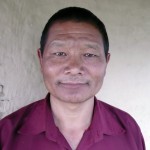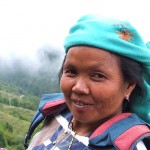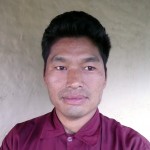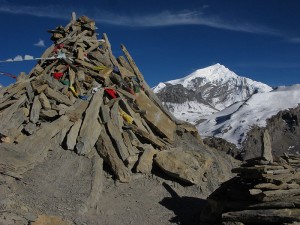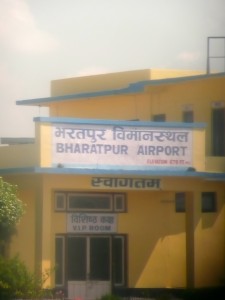Blog break until Monday October 14, 2013. Enjoy the fall!
Monthly Archives: September 2013
Chapter 6 – Bigger Dreams (cont.)
Mahabir Pun began to expand the teaching pool by hiring a retired Gurkha from Nangi, called Padam, who was fluent in English. He taught English to the eighth and ninth grade classes. I met Padam when I first went to Nangi in 2002. He was my Nepali teacher. He was a kind man who was very patient with my fumbling language skills. He died a few years later from complications of alcoholism.
Mahabir was a good teacher but he was first and foremost an entrepreneur. He knew from the beginning he would not stay in Nangi because his vision for higher education had expanded to include neighboring villages, so he set about to replace himself. Using his uncanny judgement of character, he chose teachers from the school to further their education. He contacted the American Nepal Education Foundation, the very organization that gave him grant money during his school years in Kearney. He requested they finance Bachelors Degrees for five teachers from Nangi. This was a two year degree program in
Pokhara which would certify them to teach up to the 12th grade. Four out of the five teachers completed the course in 1996 and returned to Nangi. They were; Ganga, Kishan, Prem, and Hemkumarie. All the teachers can still be found walking the school aisles except Prem who died a few years after finishing. Hemkumarie, Ganga and Kishan later returned to Pokhara for their Masters Degree in their respective disciplines. Thus having secured teachers for higher education Mahabir turned his attention to helping the village develop income earning projects.
Have you ever done such a good job that you weren’t needed anymore? Shouldn’t that be the goal of any
volunteer? Share your story with my readers and join me next week to read about the first campground which ultimately birthed the present day lodge.
Chapter 6 – Bigger Dreams
Mahabir Pun returned to Nepal in September 1992 with a bachelors degree in Science Education from UNK. He had fulfilled his dream of studying abroad but during his years in Nebraska other dreams filled the void. Never one to be satisfied Mahabir began to plan for a school in Nangi that would exceed the educational standards of Nepal in the 1990s.
But first he did what most college students do after four long years of a nose to book existence. He didn’t try to find a job. He took a break. He visited his family in Chitwan and Pokhara. He joined the tourists and trekked along the Annapurna Circuit and in the Langtang area which is north of Kathmandu. Two months after his return to Nepal he found his way to Nangi to begin the arduous task of creating a high school.
By this time the Nepal government had raised the educational bar by adding the sixth and seventh grades to the Nepali curriculum. But the teachers and principle in Nangi wanted to add the eighth and ninth grades which at that time were considered high school level classes and a prerequisite for college. They had tried before but failed due to lack of money and teachers. The government paid the teachers salaries up to the seventh grade but any education beyond this was glitter on the blackboard. Unless they could provide this higher level of education most students were stuck in Nangi never to realize their potential in college because their families could not afford to send them away to school.
So Mahabir decided to stay in Nangi during the winter of 1993 and teach. He started an eighth grade with 20 students. He taught science, math and english. He helped the school apply for higher level education using his experience and degree. His dream began to unfolded and quickly snowballed into an educational avalanche of impressive proportions. His dream not only swept along the school but an entire village and ultimately an entire country.
What did you do after graduating? Travel? Work? Decompress? Move back home? Share your experiences with my readers and join me next week to see how the school in Nangi quickly became a model for other villages.
Chapter 5 – Nebraska (cont.)
Mahabir Pun majored in Science Education at UNK from Jan. 1989 to Sept. 1992. After the first semester he was more confident in his spoken English and found the work easier, relying less and less on the voice recorder to study. Carrying heavy class loads of 18 credits a semester and taking courses during the summer he was able to graduate in three and a half years. He also took some graduate level classes anticipating he wanted to return one day for his Masters in Education.
I asked him how he liked living in the flat landscape of the midwest, especially since he was raised near some of the tallest mountains in the world. He didn’t mind the flatness because it reminded him of his family in the Terai, but oddly he wasn’t fond of the hot weather which is also steamy and jungle like in the Terai…he much preferred the cold Nebraska winters.
Mahabir told me finances were not a problem because he lived simply in the dormitory, was given three meals a day at the cafeteria and had a grant for $1000 USD/year from the American Nepal Education Foundation. Knowing Mahabir he would have left the USA in the same pants and shirt as when he arrived…but packing riches which far exceeded his expectations…riches found in the friendships and ties he formed over those years at UNK.
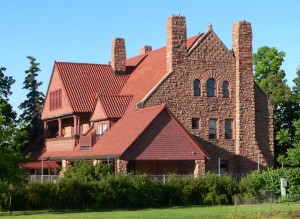
Frank House, UNK, Nebraska. Built in 1889, the house combines Richardsonian Romanesque and Shingle Style architecture. Listed in the National Register of Historic Places it now houses a museum. Photograph courtesy of WikiMedia Commons.
He was soon welcomed into Dr. Leonard Skov’s home…and heart. Leonard and Mahabir created a friendship that continues to this day…built on mutual respect and trust…key components for lasting friendships. He was also welcomed into the homes of other students, university staff and Leonard’s friends.
Have you ever found yourself in a different environment, friended by someone and given a lifetime of memories to cherish? Share your comments with my readers and join me next week as Mahabir returns to Nepal and begins to lay the foundation, both figuratively and literally, for the school in Nangi.
Chapter 5 – Nebraska (cont.)
Mahabir Pun did not spend his time in front of the TV or figuring out how to shower for very long before his first semester at University of Nebraska at Kearney went into full swing on January 9, 1989. Instead, he spent the next few years pouring over textbooks and assignments. Under Dr. Leonard Skov’s guidance he began his studies with the same fervor that the deity Manjushree (or Manjusri), a Tibetan saint, had cut the Kathmandu Valley’s Chobhar ridge in half with his mighty sword to drain the waters and expose the fertile valley. Mahabir Pun yielded his mind as a mighty sword and started the first semester with 18 credit hours of chemistry, calculus, geology, education and conversational English.
His poor skills in spoken English posed a challenge in the everyday classroom. Mahabir told me it was the main problem in the beginning…and the reason he got lost in every airport between Kathmandu and Kearney. The teachers spoke too fast and although he could read and write English he had never had the opportunity to converse except with a few tourists in Nepal. In order to compensate he started to tape all his lectures and spent hours listening to them over and over in order to complete assignments and learn the material. By the end of the fisr semester he felt comfortable talking to people in English and admits it became easier in the classroom.
He also faced another challenge posed by his Education teacher who required all assignments be typed for submission. Mahabir had never used a typewriter or computer and in 1989 there were few computers available for students on campus. He secured permission to handwrite his papers but promised to learn how to type by the end of the semester. The outcome of this challenge is a testament to his continued ability to inspire others to assist him in his quests. Mahabir told me: “One of the American students gave me his typewriter to use and I started learning to type my paper. Thus I became able to submit my final project typed in paper. The teacher was glad.”
Have you ever faced a challenge coupled by the limitations of language? Share your story with my readers. I admit to being challenged by all language, even my native tongue…thank you Associate Press Stylebook and spell check. Join me next week for more stories about Mahabir Pun’s school days in Nebraska.

